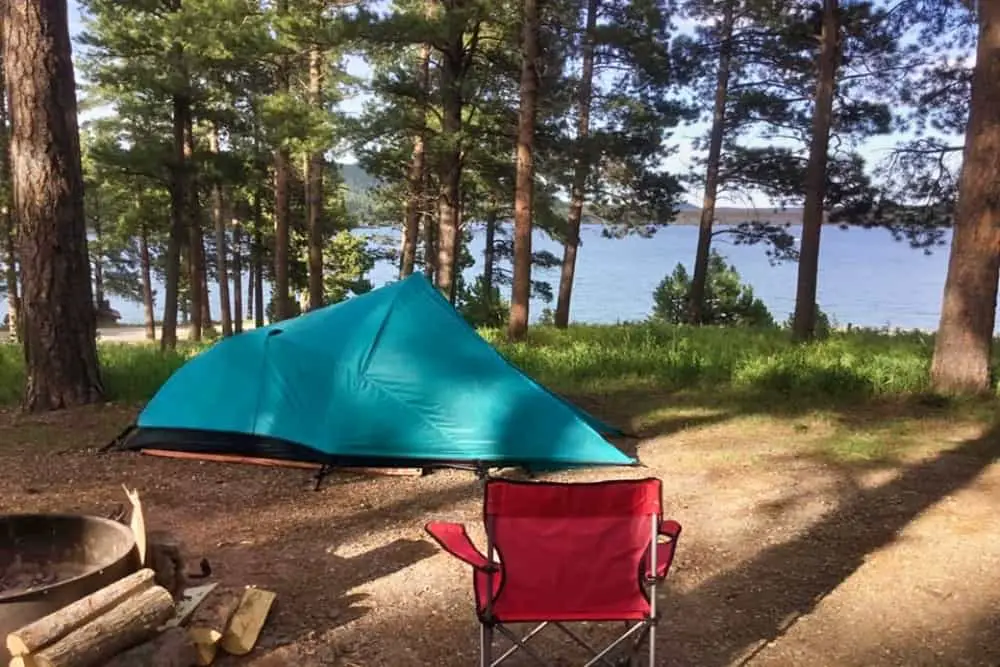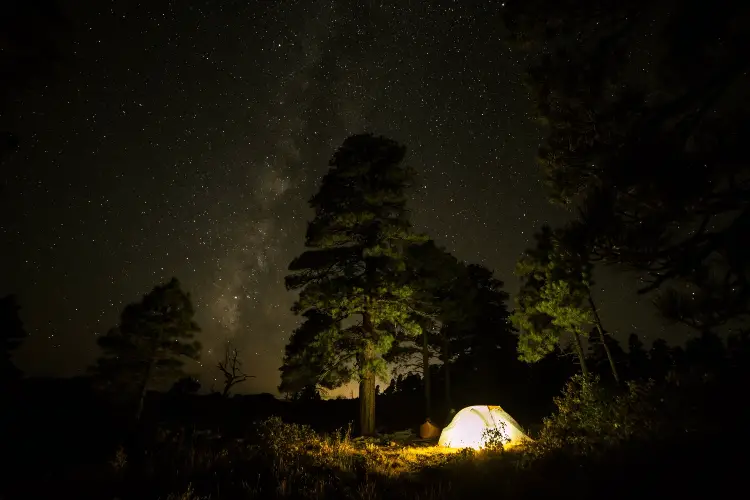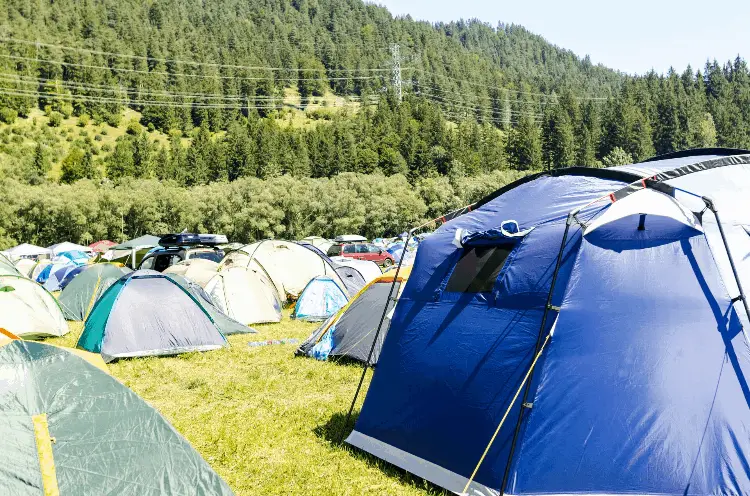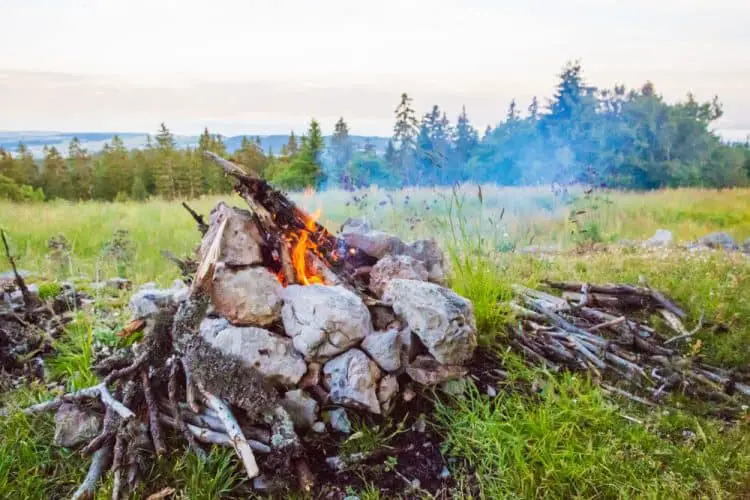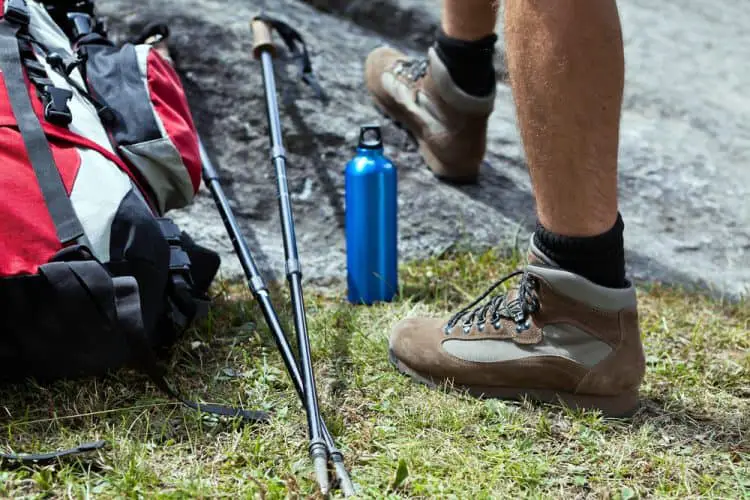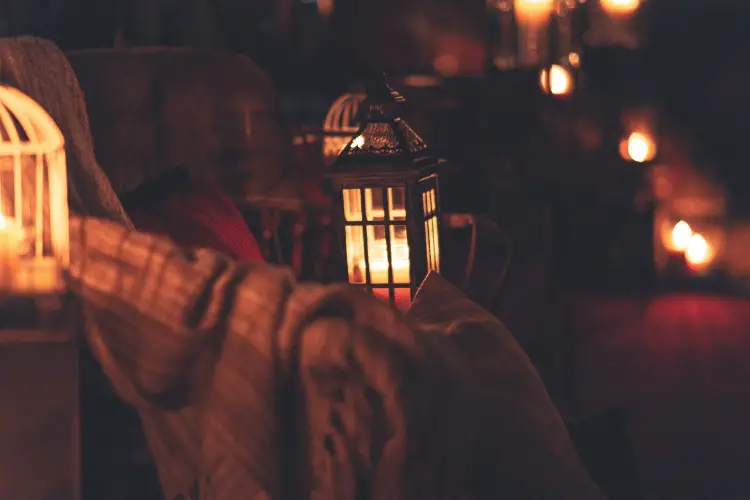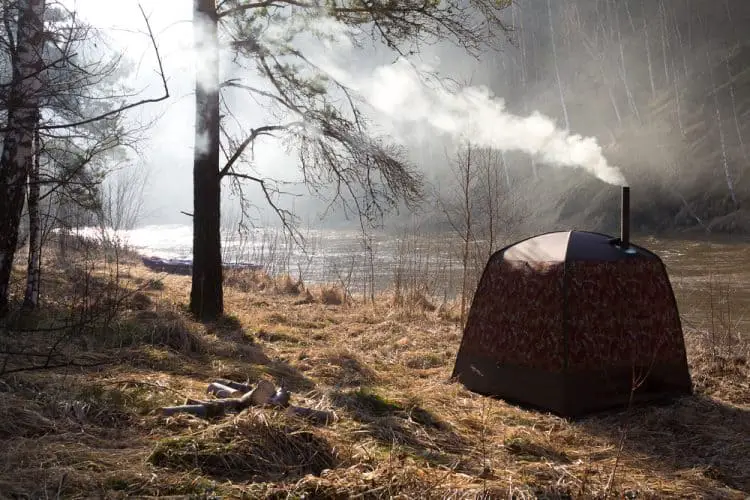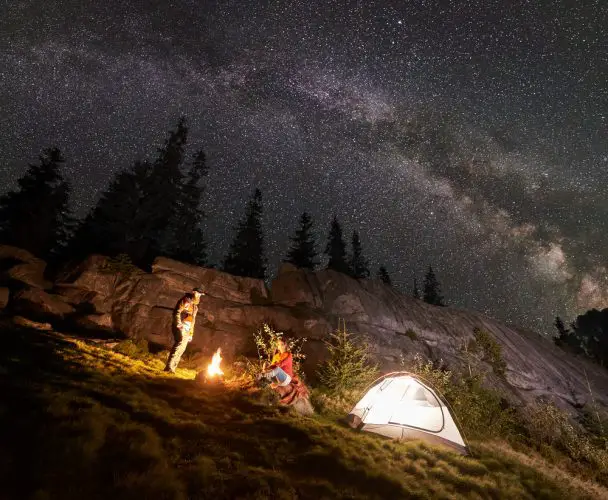How To Heat A Tent Without Electricity? (An Easy Guide)
Your tent is your home away from home, and no one wants a cold house. Except for that Wim Hof guy, but he’s crazy.
When you are out in the backcountry, you don’t have electricity or central heating, so how to heat a tent without electricity? There are many ways to heat a tent without electricity depending on how you’re camping and what type of tent you are using. When you carry a backpack, the options you have will be different from what you can take if you are using a motorized vehicle or pulling a sled in winter.
In this expert guide, I will share all my tips based on years of camping experience.
The tips you are about to learn will help you spend a warm and cozy time in your tent on those chilly nights. And yes, you don’t need electricity.
Let’s dive right in.
Why is essential to warm up your tent?
We are hairless apes who need external insulation and heating to maintain our body temperature below a certain point.
Sure enough, this temperature will vary based on the individual, but we all have that point. Having a shelter is one way to help insulate ourselves from the cold.
Your tent is a portable shelter that will help protect you from the elements and the cold.
Your first heat source is your body. Humans are very inefficient in processing energy, so we give off a lot of it as heat. The more bodies you have in your tent, the warmer it will be. The better insulated your tent, clothing, and sleep system are, the more comfortable you will be.
Exposure or hypothermia is one of the most common ways people die in the outdoors. Each year, roughly 1330 people die of cold exposure. A warm tent is one of your defenses against the cold when you are out in nature.
Depending on how cold it is, your tent, clothing, and sleep system are often enough to keep you warm, but once the temperatures drop below freezing, you may need an external heat source to keep your tent warm.
What tents are easier to heat without electricity?
If you plan on running an external heat source in your tent without electricity, you need a tent designed for it.
Since the most efficient heating will be with some form of combustion (burning of some fuel such as propane or candles), you must have adequate ventilation, so you don't succumb to carbon monoxide poisoning.
Canvas or nylon hot-tents are designed to have a wood stove. They have a heat-resistant stovepipe hole in the roof to vent the smoke. These are very effective at keeping the tent warm, but you have to have enough firewood to keep the stove and the fire going all night.
Relying on the stove for warmth means you must give yourself enough time to find and process wood so it fits in the stove.
The tent and stove combination are too heavy to carry in a backpack, so you will be pulling a sled in winter or need a motorized vehicle to carry the weight.
Double-walled tents with breathable inner walls and top vents such as 4-season mountaineering tents are warmer due to the insulating effect of trapping the dead air between the layers.
Look for models with vents on the top because trapping the air also means trapping moisture from your breath and body, which can lead to condensation.
Often, such models with vents on top are tents used in hot weather. These can be heated with candle lanterns to both warm the tent and reduce the humidity.
Single-walled tents are the least efficient for retaining heat, as there is only one layer of fabric between you and the elements. Such tents are also easier to black out in summer.
Hot tents are usually only one layer, but they work because the canvas is generally quite thick, and you have a wood stove giving off a lot of heat.
If you use a hot tent without a stove, you quickly notice how poor they are at retaining the warmth of the occupants.
Choosing the right campsite matters
Before we delve into heating a tent, where you locate your campsite can play a significant role in how warm your tent is and how you heat it up without electricity. And that will influence your camping experience.
We are trying to minimize how much the external conditions affect the temperature inside your tent, so using your environment can help improve the performance of your tent.
On a side note, if you choose a windy campsite, consider getting tent stakes specifically designed for winds. Otherwise, you will learn that your tent can fly.
Don't pick the low point
Cold air will settle at the lowest point, so if you locate your camp at a slightly higher elevation, you will avoid the most frigid air.
Even a slight rise will create an island just out of the coldest air.
Avoid exposure
But along the same idea, don't locate on a ridgeline or high point, as you will be more exposed to the wind.
Try to find natural windbreaks to shelter your tent. This will reduce heat loss due to convection. Look for a dense tree line, large rocks, or hills to protect you from the wind.
7 Genuine Ways to heat your tent without electricity
I’ve tried them all. They work like a charm if you’re prepared and know what you’re doing.
#1 Hot stones
Warning: Never use stones that have been in a stream or lake to heat. Due to the water they absorb, placing stones from the water in the fire can cause them to explode.
I have done this as an experiment and observed from a distance. A rock shrapnel flew up to 100 feet away.
An old trick is to heat stones in your campfire. The stones will retain the heat for hours after you pull them out of the fire.
This technique shouldn't be used with a nylon or synthetic tent, as the stone can melt the floor. You could put the rocks in the vestibule on the ground, but that will be of limited use in heating your tent.
To move the stones, make tongs from some sticks. I use a paracord to tie two sticks together at one end.
If you use thumb-sized branches with a slight y-shape crotch, your tongs will have some width on the end you pick up the stones.
Otherwise, you are using giant chopsticks, and hilarity will ensue as you repeatedly drop your stones.
I have used this technique effectively in a tarp tent that doesn't have the floor. The stones are on the ground where they will not melt the tent material. Just keep the rocks away from your sleeping bag or the side of your tent.
If you want to pre-warm your sleeping bag, you can heat the stones at the side of the fire and put them in a wool sock.
Then place the hose in your sleeping bag 15 minutes before you want to go to bed for a nice warm sleeping bag.
This will save you energy as you don't have to spend the calories warming up your sleeping bag with your body heat.
#2 Hot water bottle
Similar to the stones, you can use a hot water bottle to pre-heat your sleeping bag. And that will result in a warmer tent. Still, no electricity needed!
Using your stove or the fire, boil water and then place it in stainless steel or Nalgene plastic water bottle. Make sure the lid is tight and test to make sure it doesn't leak.
Put the bottle in a wool sock and place it in your sleeping bag about 15 minutes before you want to go to bed.
In addition to warming your sleeping bag, it also has the bonus of keeping a bottle of water from freezing overnight, so you have water for making breakfast and, if needed, melting snow. Just push the bottle to the foot of your sleeping bag when you get in.
By the way, we have a detailed guide of the most trusted backpacks with sleeping bag sleeve in case you’re wondering how to carry your sleeping bag when backpacking.
You never want to melt snow in a pot on a fire or stove without first having a bit of liquid water in the bottom of your pot. Since snow is mostly air, you will scorch your pot, and your water will taste like burnt popcorn.
#3 Candle Lanterns
The company UCO came out with candle lanterns in 1971, making them as old as I am. This ingenious little invention is a candle in a little glass and aluminum lantern.
It collapses for storage and protection. The base of the candle holder is spring-loaded, so as the candle burns, it automatically pushes up, keeping the flame in the glass chimney.
They come with a bail and chain with a hook that allows you to hang them from the top of your tent. The distance is enough that you won't melt the fabric of the tent or any other parts.
They make candles that burn for 9 or 12 hours, so it is a viable option to use when you need to add warmth for a more extended time.
Like anything that uses combustion, you must ensure that you have adequate ventilation to reduce the risk of carbon monoxide poisoning. They make them in single and three candle versions. The single will take the chill off in colder three-season conditions, but you will need the three candle models for colder conditions.
They aren't going to heat your tent like a wood stove or propane heater, but they do cut the chill and add romantic lighting if that is your thing.
The three candle model called the Candlelier is broad enough that you can use the top as a small stove for heating drinks.
Additionally, the candle lanterns are excellent at removing moisture from the air, dramatically reducing the amount of condensation you will get on the inside of your tent. Damp air has a chilling effect, so reducing it will make your tent feel warmer.
Not to mention that condensation is an enemy to the waterproofness of your tent. In addition, lanterns could help you dry out your tent easily if it gets soaked.
#4 Battery-powered heaters
You won't find any battery-powered heaters that put out enough heat to warm a tent as the power draw is just too high.
You would have to lug around a car-sized battery, and that wouldn't even give you an entire night of heat.
Powered hand warmers, socks, and jackets exist, but are limited by battery run time. If the temperatures are below freezing, it becomes even more of a problem as batteries don't charge well in the cold.
With that being said, for winter camping, when the temperatures are sometimes extreme, you can use portable body heaters that operate on batteries.
They will surely warm you up for some time, but won’t do miracles in warming up your entire tent.
#5 Heating packs
In cold weather, a handy thing to bring along is chemical heating packs.
They are in a sealed package, but they will produce heat for 5-12 hours depending on the size when exposed to oxygen. Anything that helps keep you warm will have the same effect as warming your tent. These won't be enough to heat your tent for long, but can help keep you warm. You can get them in hand, toe, foot, and a larger size that sticks on to fabric.
You can put the hand warmers in your pockets or gloves. I use them in my chalk bag when climbing in the cold to warm my fingers.
The foot warmers go in your boots, and the toe warmers go on the top of your toes. These can be good on the move when you aren't generating much heat, such as riding a snowmobile.
The larger stick-on packs help keep you warm when sleeping. Place them on your base layer over your kidneys, in your armpits, or between your legs.
These areas all have a lot of blood flow, so warming them up helps warm the rest of the body.
#6 Propane heaters
When space and weight aren't an issue, a propane heater can be an efficient option. Great for basecamp setups, where you have a vehicle to bring in your camping gear.
Small propane heaters like the Mr. Heater Buddy series give off enough heat to keep an ice fishing hut comfortably warm. Watch the interesting video below for more info on Mr. Heater Big Buddy.
You can use them in a camping tent, but like all heaters that use combustion, make sure you have adequate ventilation.
Ideally, you would have a vent point low and high to create a convective current that will allow oxygen in and vent out carbon monoxide.
When using a propane heater, keep it away from the walls of your tent, especially if your tent is made of nylon, as fire is a risk.
Most propane heaters are designed to use one-pound canisters that are non-refillable. You can use a 20-pound refillable propane take as you would have on your bbq with the correct adaptor hose.
Using a 20-pound tank will give you much longer burn times, reduce waste and be much cheaper.
#7 Wood Stove
Winter camping has grown in popularity in large part due to the availability of hot tents. These heavy canvas tents are designed to use a wood stove to keep them warm.
Made with a heat-resistant vent hole for the stovepipe to go through, they can make a -40 night remarkably comfortable.
The wood stoves that companies match with hot tents are small and pack up. Everything fits together for more efficient transportation and space saving.
The combination of tent and stove is usually over 50 lbs, so you will need a sled to pull it, making them only viable in winter when traveling on foot.
As long as you are in wooded areas, you can find deadwood dry enough to burn in the stove. Since the pieces of wood will have to small enough to fit, you will have to bring wood processing tools, including a saw and an axe.
It takes a lot of wood to keep a tent warm all night, so allow yourself at least two hours before dark to find and process it all.
Aside from the heat, the stove gives you a place to cook and boil water to melt snow. The amount of heat emitted also allows you to dry any damp clothing, so bring some cord to string up a clothesline within the tent.
Besides immensely helping in heating up your tent without electricity, the smoke from the woodstove keeps the bugs away.
What heaters are safe to use in a tent?
Any heaters that use combustion, whether wood, propane, or a candle lantern are safe for heating up a tent without electricity, as long as there’s adequate ventilation.
Either open the vestibule slightly or use a tent with top vents and make sure you peg out the fly to allow air in from below.
Stargazing tents are very appropriate for that matter, since they naturally offer great ventilation.
It would be best if you only used wood stoves in tents without a floor, so any embers that may fall out don't catch the floor on fire.
Tents designed for the stoves will place the vent pipe far enough from the walls that the tent walls aren't at risk from the heat emitted.
7 Tips on staying warm in your tent
No matter if you use electricity to produce heat or not, staying warm in your tent can be enhanced by understanding how we produce heat and retain it.
#1 Hot drinks
When you are in your tent, drink a hot drink like hot chocolate or tea. This will help warm your core, which will help keep the rest of you warm.
Keep a thermos filled with hot beverages for a quick warm-up.
#2 Eat Big
Your body needs calories to generate heat.
We all know that eating late will make us fat. However, eating some calorically dense foods before bed to help your body stay warm when camping in the cold is a sound idea.
High-fat and protein-rich options such as nuts are easier for your body to turn to heat. You don’t have to be on a keto diet to eat high-fat foods, you know.
#3 Cover Your Head
A hat can do a lot to help retain body heat. We lose a lot of warmth through our heads, so insulating up top can make a noticeable difference in your comfort level.
We have a solid list of the warmest hats this season.
#4 Insulate underneath
It isn't just cold air that saps our body heat. The cold of the ground will leach away warmth as well.
Using an insulated sleeping pad, you magnify the effectiveness of your sleeping bag by keeping you warm on all sides.
#5 Don't go to bed cold
You want to be comfortably warm when you get in your sleeping bag, so it doesn't take a lot of energy to warm it up.
#6 Exercise will warm you up
If you have been sitting around a campfire before bed, you might find yourself a little chilled due to a lack of movement.
Before getting in your sleeping bag, do some exercise like squats or jumping jacks to get the blood moving and warm-up.
#7 Alcohol doesn't warm you up
Don't drink alcohol when you are cold. While it might feel warm going down, alcohol drops our temperature.
Keeps those tasty beers for the day.
Conclusion
Staying warm on a chilly night makes your camping trips more fun and safer. A comfortable environment is a combination of your shelter, clothing, sleep system, and you.
Learning how to heat a tent without electricity is just one step on your way to being a master outdoors person.
Please think of how all of your systems work together to maintain your core body temperature and optimize them a little more each trip.
Winston Endall
Having worked in the outdoor, fitness, and cycling industry his whole life, Winston brings a wealth of real world knowledge on the topics. Rock climbing, backpacking, cycling and wilderness survival are his life. As both an athlete, coach and outdoor educator, his practical experience translates into his writing to help people better pursue their outdoor passions.. Read more about Winston here.

